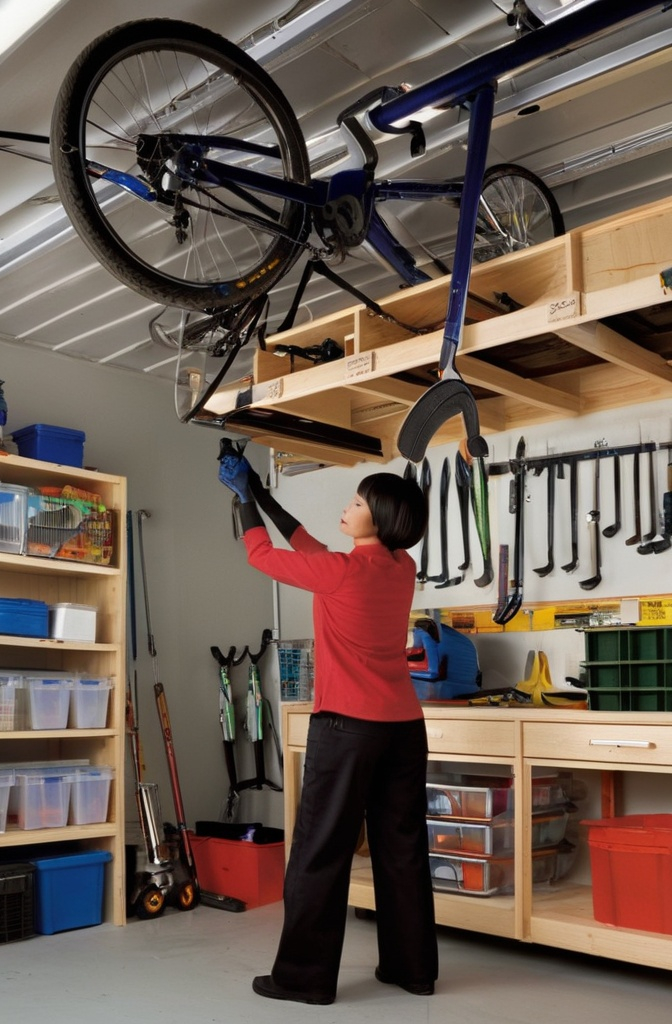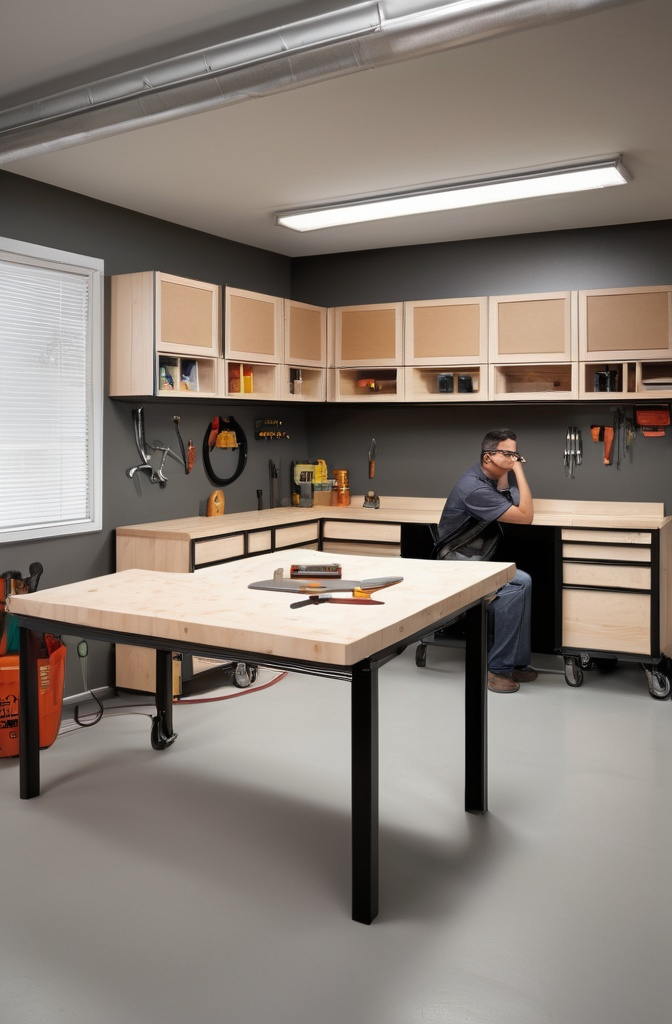If you’ve ever stood in the middle of your garage, holding a screwdriver in one hand and a half-eaten sandwich in the other, wondering where the heck your socket wrench ran off to—this one’s for you.
Setting up a garage workshop isn’t just about where you put your bench or what kind of shelving you use. Nah, it’s an ecosystem. A moving, humming, dust-swirled habitat where form, function, and frustration often collide.
Now, let’s not pretend everyone’s got 1,000 square feet to play with. Some folks are workin’ with a glorified closet, while others could probably house a small aircraft. Either way, we’re gonna work with what you’ve got—and we’re gonna do it smart.
Here’s 20+ workshop layout ideas to help you stop losing tools and start building masterpieces.
1. The Triangle Flow Layout

You’ve probably heard about the kitchen work triangle, right? Stove, sink, fridge. Well, take that same principle and slap it onto your garage.
Place your workbench, tool storage, and main machinery (like a miter saw or drill press) in a triangle formation. This lets you pivot between stations without walkin’ miles. You’re not trying to reach your step goal. You’re tryin’ to finish that birdhouse.
One quick turn and boom—you’re grabbing your chisel instead of knocking over a paint can. Feels good.
2. Wall-Hugger Layout

Let’s be real: garages are usually multi-tasking nightmares. Car on one side, trash bins on another, your uncle’s broken weed whacker in the middle like it’s on display.
So, hug the walls.
Build out your workspace along one or two walls. Pegboards, wall-mounted shelves, folding benches—make everything come to you. Not the other way round.
Even your cat will appreciate the extra floor space.
3. The Rolling Island

Ah, mobility. The unsung hero of modern workshops.
Build or buy a rolling workbench. Not too heavy, not too light. Slap some locking casters on it, and boom—you’ve got yourself a workstation that goes where the work is.
Cutting wood? Wheel it next to the miter saw. Assembling a frame? Move it under the best light. Dropped a nail and don’t feel like crawling? Just push the bench out the way and grab it.
Freedom tastes like WD-40.
4. Zone Defense Layout

This one’s for the planners. The thinkers. The “I label my drill bits” type of people.
Split your workshop into zones. One for cutting, one for assembly, one for storage, one for… sitting there in thought while holding a clamp and contemplating life.
Each zone gets what it needs: tools, lighting, bench space. So you ain’t running a mile just to find your belt sander every time you need to flatten an edge.
Simple. Logical. Almost too easy.
5. Ceiling Storage Wizardry

People forget to look up. There’s a whole world up there, above the mess.
Mount overhead shelves or pulley systems for things you don’t use daily. Seasonal tools, wood stock, boxes of mystery cables from 2006—put ‘em up top.
Out of sight. Out of mind. But not out of reach.
Heck, install a winch. Lift your bike up there too. Why not?
6. Fold-It-Away Fantasy Layout

This one’s for the space-starved. The folks whose workshop doubles as a laundry room, dog kennel, and illegal hockey rink.
Go modular. Get a folding bench. Wall-mounted work tables. Drop-down tool racks. Use those hinges, baby.
With a flick of the wrist and a whisper of a curse word, your garage turns from chaotic storage shed to a lean, mean building machine.
Then folds right back up when your spouse wants to park their car.
7. Light It Like a Movie Set

Okay, maybe this ain’t a “layout,” but it’s a game-changer.
Too many garages rely on one sad bulb hangin’ from the ceiling like it’s clinging to life. You deserve better.
Layer your lighting: overhead LED panels, under-shelf strip lights, task lamps with those bendy arms that make you feel fancy. Your eyes (and fingers) will thank you when you’re not sanding in the shadows like some medieval carpenter.
Mood lighting for your hammer swings.
8. The U-Shape Command Center

Got a bit of room to play with? Wrap your work zone around you like a warm, tool-filled hug.
Set up benches and shelving on three sides, forming a U-shape. Everything’s within arm’s reach. No spinny office chair required—though it’s totally allowed.
You’re not moving around your tools anymore. They’re orbiting you.
Just don’t trap yourself in there. Leave an exit path. Learn from my mistakes.
9. The Dusty Sidekick: Dedicated Dust Zone

If your lungs could talk, they’d be yelling at you right now.
Every time you cut, sand, or drill, dust is flying around like it’s got somewhere to be. It doesn’t. It just wants to ruin your tools and take up residence in your nose.
Create a dust-control zone.
Set up a dust collection system or, at the very least, a shop vac with some serious suck. Mount it near your cutting station. Add airflow vents if you’re feeling fancy.
Wear a mask. And maybe stop pretending you’ll clean it up later. You won’t. Nobody ever does.
10. The Creative Chaos Layout

You know who you are.
You’re not gonna follow a grid or a chart. You work best surrounded by a lovingly chaotic mess of creativity. And that’s okay. But even chaos can be optimized.
Group your clutter by project type. Keep electrical stuff in one spot. Carpentry in another. Paint supplies… somewhere not next to your lunch.
Use labeled bins. Stack clear containers. Hang stuff you use all the time—pliers, mallets, your lucky tape measure.
Basically: it’s okay to be messy, just not stupid-messy. Your creativity deserves a functional storm.
11. The L-Shape Lowkey Genius Layout

Sometimes, one corner is all you need. With an L-shaped layout, you tuck your workshop neatly into two adjoining walls, forming a natural corner of power.
Put your bench along one wall and your tools and storage on the other. It’s compact, efficient, and makes you feel like you’re piloting a tiny productivity spaceship.
Bonus: perfect for garages that share space with a freezer or the dog’s favorite nap zone. Minimal invasion. Maximum flow.
12. Lazy Susan for Tools (Yes, Really)

Why reach when you can spin?
Install a large, heavy-duty rotating tool platform—essentially, a Lazy Susan but beefed up and made to hold drill bits, clamps, hand tools, or even entire toolboxes. You stand in one spot and rotate your tools into view like you’re hosting the Price Is Right.
Effort? Minimal. Fun? Too much.
And yeah, your buddies are gonna ask how you thought of that. Don’t tell ’em. Let it remain a mystery.
13. Magnetic Wall Madness

This one’s for the folks who are tired of digging through drawers for that ONE screwdriver.
Cover an entire wall—or even just a strip near your bench—with heavy-duty magnetic panels. Slap your tools right on there. No hooks. No shelves. Just raw, magnetic satisfaction.
Screwdrivers. Wrenches. Scissors. You name it.
Looks cool. Works better. And makes you feel like a wizard every time you grab something mid-project.
14. The French Cleat Jungle

French cleats aren’t just a fancy name. They’re basically LEGO for adults who like to build stuff.
Line your workshop walls with a French cleat system—angled wooden rails that let you hang tool holders, bins, or shelves anywhere you want. And you can move ’em. Anytime. With zero drama.
You wanna switch your clamp rack with your glue shelf? Done in seconds.
It’s the closest you’ll ever get to rearranging your garage like a video game inventory screen.
15. Under-Bench Secrets

Why’s everyone so obsessed with walls and ceilings? There’s gold under your bench, friend.
Use the space beneath your workbench for deep drawers, pull-out organizers, or even slide-in rolling carts. Hideaway stations for sanding gear, paint cans, or the backup set of pliers that only come out in emergencies.
It’s stealth storage. The kind that makes you feel smart and smug. In a good way.
16. The Clamp Highway

If you’ve ever tried to find a clamp mid-glue-up and realized they’re all tangled together like some medieval torture chain… this one’s for you.
Install a long, narrow rail or pipe along a wall or overhead beam. Hang all your clamps in a row. Easy to grab. Easy to return. No cursing involved.
You’ll feel like you’re walking through a hardware aisle in your own garage. Which is peak DIY fantasy, honestly.
17. Pegboard Carousel (Trust Me)

We’ve all seen the classic pegboard wall. Yawn. Let’s remix it.
Build a freestanding, spinning pegboard tower—like a vertical rotisserie of tools. Hang wrenches, brushes, chisels, whatever. It spins, so you don’t need much space.
You’re not bound to one wall anymore. The whole thing lives in the middle of your shop like a funky totem pole of usefulness.
Looks a bit strange. Works like a dream.
18. Color-Coded Chaos Control

Ever open a drawer and forget what half the stuff even does? Yeah. That.
Introduce color zones into your garage.
Paint your storage bins, drawers, and wall sections based on categories: red for power tools, blue for painting supplies, yellow for fasteners, etc. You’ll find things faster, and it looks oddly satisfying.
Also helps if you’ve got helpers—family, friends, confused teenagers—wandering in asking where the sandpaper lives. Now they’ll know.
19. Split-Level Stations

If you’ve got some vertical space (and maybe a little daring), try a multi-tiered work zone.
Build a tall bench with a lower pull-out shelf underneath for seated tasks. Or a small step-up station for precision work. Stack parts of your workspace so you’re not always adjusting the bench height or compromising on comfort.
Different tasks need different elevations. Accommodate ‘em. Your back will send you thank-you cards.
20. The Blueprint Nook

Every workshop deserves a tiny corner of calm.
Set aside a quiet little design or sketching nook. Doesn’t need to be big. Just a stool, a surface, and maybe a corkboard or clipboard wall for hanging plans.
It’s where you brainstorm, scribble bad ideas, or stare at a woodcut for 20 minutes before realizing you measured it backwards.
Bonus Thoughts, Because Why Not
Workshops are personal. Sacred, even. Yours should feel like your space. Not something copied off Pinterest with no soul.
Hang a calendar. Mount a Bluetooth speaker. Keep a mini fridge full of suspiciously warm soda cans. Maybe even a chair you definitely didn’t steal from the dining room set.
This is where your hands get dirty, your ideas get born, and sometimes your coffee gets spilled all over the table saw.
That’s fine. It’s part of the deal.
Optimize, Don’t Obsess
One more thing—and this is important.
You don’t need the perfect layout. You need a layout that works for you. Your projects. Your budget. Your weird, wonderful way of working.
Start small. Move stuff around. You’ll know when it clicks. It’ll feel like you just installed new brain RAM. Like you can finally breathe in the garage instead of trip over a toolbox.
No shame in trial and error. Heck, error’s half the reason half of us got into building things in the first place.
So go ahead. Tape out shapes on the floor. Stack some crates and see what sticks. Make a mess. Make it better.
Then invite someone over to see your setup, even if all you’ve built is a wooden spoon.
You earned it.
Wanna talk tools next?
FAQs
What is the best layout for a small garage workshop?
The Wall-Hugger or Fold-It-Away layout saves space and keeps things tidy.
How do I organize my tools efficiently?
Use pegboards, magnetic strips, and labeled bins to keep tools visible and accessible.
Can I build a mobile workbench myself?
Yes, it’s a simple DIY project using plywood, casters, and basic hardware.
What’s a French cleat system and why use it?
It’s a wall-mounted rail system that lets you easily rearrange storage without tools.
How do I improve lighting in my garage workshop?
Layer overhead LEDs with task lighting and under-shelf lights for full visibility.
What’s a good way to manage dust in my shop?
Set up a dust zone with a shop vac, air filter, or dust collection system near cutting tools.
How can I store rarely used tools or materials?
Use overhead ceiling storage or under-bench drawers to keep them out of the way.
Are clamp storage systems worth it?
Absolutely—rails or clamp walls save time and prevent tool clutter.
What’s the benefit of color-coding my workshop?
It speeds up tool finding and helps maintain organization across categories.
Do I really need a design or blueprint nook?
Yes, having a small planning space boosts creativity and reduces build errors.

Emma is a passionate home decor enthusiast and the voice behind Home Evoke. With a keen eye for design and a love for transforming spaces, she shares her expertise and creative ideas to help others create beautiful, functional homes. Through her blog, Emma inspires readers with practical tips, trend insights, and DIY projects that make home styling effortless and enjoyable.

